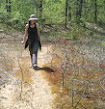
Beavers, opossums, deer, foxes, coyotes, rabbits, skunks, mink, porcupines, ground hogs, bats, turtles, snakes, frogs, fireflies, owls, golden eagles, white pelicans and 300+ more bird species … yup, all here in the city of Toronto, just trying to stay alive and keep a home, like you and me.
Yesterday we saw our first baby raccoons this season. It’ll be awhile yet before we come across displaced baby birds. In between, we notice that once the daffodils come up, the baby squirrels start to fall down (sadly, often off of high roofs and onto pavement = bleeding-out-the-nose irrecoverable head injuries; while others just have mild hypothermia and dehydration and can be warmed, hydrated, stabilized and re-situated the same day).
What should you do when you come across distressed wildlife in your yard?
“First do no harm”...but how do you even know which interventions are a good or a bad idea? (I wish that gardening, stewardship and hort / botanical societies would give practical workshops on this. Wildlife is what you get when you're a gardener / growing wildlife food and shelter). It's way less stressful for you and the animal if you have a bit of a plan ahead of time (like how, ideally, you take 1st aid or CPR course before you need them), so check out the Toronto Wildlife Centre, Toronto Humane Society Wildlife Rehab, and for birds, FLAP. If you get up into cottage country, you'll be interested in the Muskoka Wildlife Centre and A Wing and a Prayer.
***
 Want to attract and nurture wildlife in your backyard? See the Canadian Wildlife Federation's Attracting Wildlife page. You'll also be interested in Douglas Tallamy's Bringing Nature Home: How Native Plants Sustain Wildlife in Our Gardens. Tallamy is the Chair of the University of Delaware's Department of Entomology and Wildlife Ecology = he knows his stuff, and better yet, he writes in accessible plain language. I think this one's bound to be essential reading for native plant gardeners (and anyone interested in back yard ecology, including native pollinators, but that’ll have to be another post.) BTW: the cost of this book varies wildly, I've started using all bookstores.com to find best the price.
Want to attract and nurture wildlife in your backyard? See the Canadian Wildlife Federation's Attracting Wildlife page. You'll also be interested in Douglas Tallamy's Bringing Nature Home: How Native Plants Sustain Wildlife in Our Gardens. Tallamy is the Chair of the University of Delaware's Department of Entomology and Wildlife Ecology = he knows his stuff, and better yet, he writes in accessible plain language. I think this one's bound to be essential reading for native plant gardeners (and anyone interested in back yard ecology, including native pollinators, but that’ll have to be another post.) BTW: the cost of this book varies wildly, I've started using all bookstores.com to find best the price.
Also, if you're in Ontario and you think you have serious wildlife habitat you want to identify and protect, see the OMNR's Significant Wildlife Habitat - Technical Guide -- interesting reading for field naturalists too.
 Want to attract and nurture wildlife in your backyard? See the Canadian Wildlife Federation's Attracting Wildlife page. You'll also be interested in
Want to attract and nurture wildlife in your backyard? See the Canadian Wildlife Federation's Attracting Wildlife page. You'll also be interested in 


No comments:
Post a Comment